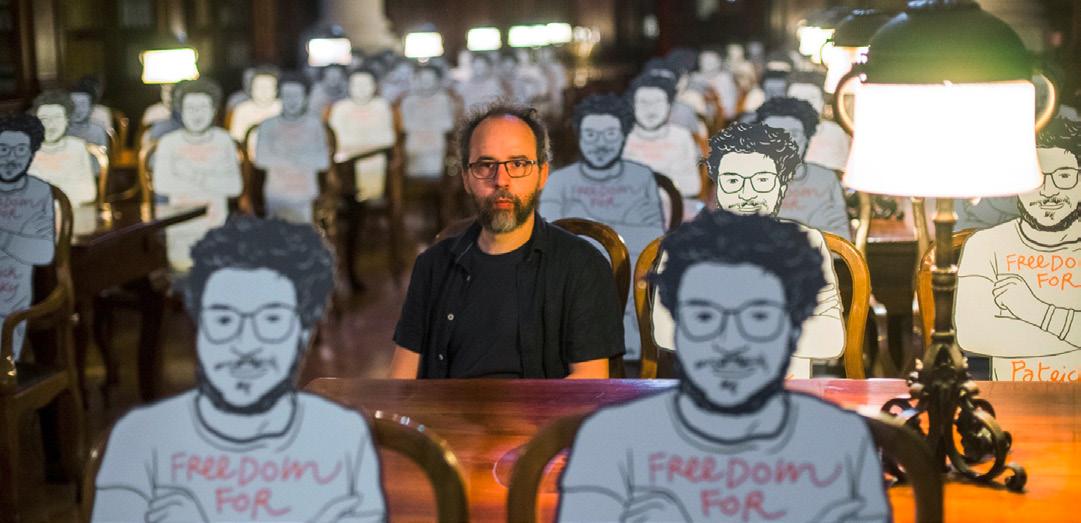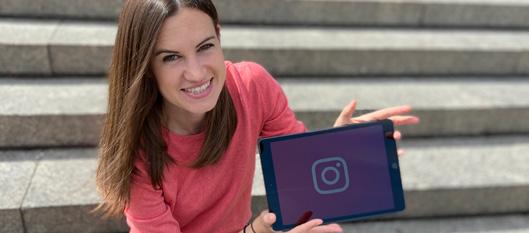
9 minute read
Encounters
Returning to Washington

DW’s Washington Bureau Chief Ines Pohl
© DW
Advertisement
“Since I started working as a journalist, I have been concerned with the question of what holds societies together and what divides them,” says Ines Pohl. She joined DW in 2015 as correspondent in Washington and has recently taken over leadership of DW’s Washington bureau.
Looking at recent political and social developments, she believes that there is no better time and place to investigate such questions. “I have known and loved the United States for decades. I hope to understand what has happened, what is going on in this country and what the world must prepare for,” she says. She is passionate about human rights and the role of democratic structures and legitimacy and seeks to understand how they can protect themselves from being captured by autocrats and populists.
Pohl served as DW’s editor-in-chief from 2017 to 2020. During her three-year tenure, she focused on increasing DW’s social media presence and the exclusive content of all 30 language services. She is a strong advocate for using social media to enhance the connection between audiences and journalists in the digital age.
On one of her first assignments, she covered the protests against police violence in Chicago. “I want to know how the wounds of the past can heal and how we can prevent the fear of social relegation from turning into exclusion, worries or hate.”
Art meets activism: Spotlight on Gianluca Costantini
Gianluca Costantini, the creator behind this issue’s cover, is an Italian artist, activist, cartoonist and illustrator. He hopes to empower citizens by raising awareness of global injustices and human rights violations, especially restrictions on freedom of expression and of the press.
This issue’s cover refers to journalists who are facing assaults and arrests while performing their duties.

Gianluca Costantini’s art installation “Sitting next to Patrick Zaky” in the University Library in Bologna. He is calling for the release of the student Patrick Zaky who is detained in Egypt.
© Michele Lapini
“I’m trying to create art which has an impact on the system and which tries to change it—or at least question it.” In some of his drawings, Costantini calls on governments to release imprisoned journalists. This has led to some of his art being censored online by the Turkish government. “I look for art that has a strong intersection with communities, that shares and doesn’t impose anything. Art to me is a way to travel among hardship, a different way to work on politics and society. Art is a tool that prevents me from looking the other way. I’m an artist and an activist at the same time, I like the term artivist. I use the practices of activists and I support them, but I’m always an artist,” says Costantini.
The ‘artivist’ has also worked together with NGOs such as Amnesty International, Oxfam, several human rights festivals and Words Without Borders. In 2017, he was nominated for the European Citizenship Awards. In 2019, he received the Art and Human Rights Award from Amnesty International.
More of his works can be found in this edition and on his website: www.gianlucacostantini.com

© Gianluca Costantini

© Gianluca Costantini
‘Mozart would have been a good Cuban’
Horn player Sarah Willis has been a member of the Berlin Philharmonic for 19 years. For a unique musical encounter, she traveled to Havana and combined classical music with Cuban rhythms.

© Rittershaus
At first, her new solo album “Mozart y Mambo” seems like an unusual combination as many people would not immediately associate Wolfgang Amadeus Mozart with Mambo. “There is a statue of Wolfgang Amadeus Mozart in Havana. On my first visit to Cuba in 2017, I was told by one of the local musicians that Mozart would have been a good Cuban. I was intrigued by this comment and thus began the inspiration for this album which was recorded in Havana in January 2020,” says Sarah Willis. She went to Havana to give a French horn masterclass and was surprised by how many horn players turned up. As soon as she started to explore the classical music culture of Cuba, Mozart’s statue in Old Havana began to make complete sense to her. “I decided then and there to do what I could to raise awareness of the wonderful classical music-making going on in Cuba,” she says.
The result is a unique musical program that combines the horn concertos by Mozart with traditional Cuban music. DW broadcasts the documentary Mozart y Mambo: A Cuban Journey with Sarah Willis as part of the program Arts.21 and on the YouTube channel DW Classical Music. The album “Mozart y Mambo” was released by Alpha Records.
Ideas for more inclusion
DW employee Kay Macquarrie has invented an app to promote barrier-free travel with German rail operator Deutsche Bahn.

Overcoming hurdles: Kay Macquarrie wants to make train travel easier for wheelchair users
© private
Book a train ticket, take your luggage and set off—commuters know the game. But for people with disabilities, booking travel alone is a major hurdle: from having to register at least 48 hours before the planned time of departure to filling a form with up to 79 fields.
Kay Macquarrie would like to change that. He has developed an app to make train travel easier for wheelchair users. He estimates that it will take at least 20 years before rail travel is be completely barrier-free, from booking to the platforms. A spokesperson of the German rail operator Deutsche Bahn agrees with this assessment. Macquarrie’s ideas will now be incorporated into the new booking system that Deutsche Bahn is currently working on.
Think sustainably. And act.
DW reports extensively on environmental and social issues through formats such as the multimedia platform Global Ideas and the TV magazines Eco India and Eco Africa. In addition to this, DW also takes responsibility for the people within the company and the environment.
This approach is reflected in the company’s new corporate goal on sustainability and manifested in the establishment of a new department—and in the publication of a sustainability report.
The report will be published biennially. “This is the first review of the period from 2018 to 2020,” says Johannes Hoffmann, head of General Management, and one of the three authors of the report together with Benjamin Rietdorf and Thilo Pommerening.
It describes DW’s commitment in the areas of environmental, social and sustainable corporate governance. In the environmental field, one highlight is the promotion of renewable energies by purchasing green electricity, photovoltaic and solar thermal systems, charging stations for electric vehicles and the conversion to efficient LED lighting in the studios. In the social area, DW also provides many benefits and offers for employees, such as additional childcare allowance, a parent-child office, free language courses and a subsidized transport ticket. DW is the first ARD member to document its commitment to sustainability.
DW on TikTok
DW is now also on the social media platform TikTok, addressing users aged between 14 and 26 years with the channel dw_berlinfresh.

Exploring historic sites in a TikTok video
© DW
dw_berlinfresh offers a closer look at culture and everyday life in Germany and Europe. “With Berlin Fresh, we want to take an entertaining look at the lives of young people in Germany and Europe,” says Rolf Rische, head of DW’s department Culture and Life, which developed the format.
The channel will feature well-known DW faces, up-and-coming reporters as well as established TikTok stars. Among others, DW will cooperate with TikTok star Bartmann (@bartmann1). The Australian, who works as a teacher at a German school, is a wellknown figure on the video platform and has more than 700,000 followers.
The video app TikTok is currently growing faster than any other social media app. According to the company, TikTok is available in 150 markets and in 75 languages. An estimated 800 million users worldwide watch the short videos every month. The video sharing app has also become a platform for ideological formation on political matters as well as activism.
TikTok dw_berlinfresh
‘Meet the Germans’ now on Instagram
From beer to nudity and ridiculous grammar—Meet the Germans uncovers the quirks and idiosyncrasies of the German culture sharing insider tips and a light-hearted but informative look at life in Germany.

© DW
“With Instagram we can offer our viewers even more: Be it videos, pictures, stories or live streams. In addition, this will enable us to get even closer with our audience,” says Rachel Stewart.
Presenter Rachel Stewart was born in the UK and has been living in Germany since 2016. She explains in her social media videos the peculiarities of Germans and of the German culture such as small talk, the love of allotment gardens, women in Germany and the German sauna “cult.”
The Meet the Germans team also produces fact-based, informative and entertaining videos on complex topics such as equal rights or digitalization.
www.dw.com/meet-the-germans
Instagram @dw_meetthegermans

Meet the team behind #meetthegermans (clockwise from top left): Rachel Stewart, Cristina Burack, Jenipher Camino Gonzalez, Sam Baker, Ineke Mules and Klaudia Prevezanos
© DW
The Russians — An Intimate Journey from Birth to Death
DW’s former Editor-in-Chief Ines Pohl and DW’s Moscow Bureau Chief Juri Rescheto initiated and promoted the documentary The Russians. The film follows the lives of Russians from six different generations revealing a Russia beyond Moscow and the Kremlin.

Juri Rescheto with producer Marina Ivanova during a shoot in a hospital in Chelyabinsk in the Urals, in the mirror camera operator Maxim Tarasyugin can be seen
©DW/M. Tarasyugin

Juri Rescheto talks to a 96-year-old protagonist in the Republic of Bashkortostan, a federal subject of Russia
© DW/M. Tarasyugin
In the two-part-documentary, the audience meets a nation poised between tradition and the future. Viewers experience impressions of a world power with a shrinking population, many ethnic minorities, huge geographical distances, social tensions and “great people who seek their fortune despite all resistance. And find it,” says filmmaker Juri Rescheto. “Russia plays a very important role on the world stage. With this journalistic project, we are giving a close-up view of everyday life in this fascinating country,” Ines Pohl says.
Rescheto traveled across the country, meeting with Russian citizens who shared their everyday lives with him. They talk about their joys and sorrows, their hopes and needs, and their good and bad experiences. The film shows intimate scenes from their homes and workplaces, as well as glimpses of their political views, their standards of living, and their customs. The protagonists’ personal situations are presented based on official Russian studies on their respective generations.
In Part 1, viewers get to meet Jelena in a city halfway between Moscow and Novosibirsk. She works as a surrogate mother in a
children’s home. The journey continues to the boreal forest in western Siberia to 16-year-old Veronika, who spends most of the year at a boarding school. Her parents are reindeer herders and members of the indigenous Khanty people. Young adults are represented by Kirill, who has a normal job, but spends his free time practicing a dangerous hobby: no holds barred-boxing.
Part 2 of the documentary introduces Dmitri, who lives in northwestern Russia and works at Europe’s largest blast furnace. He is a proud steelworker and admires Vladimir Putin. At Lake Baikal, Baba Lyuba tells many stories about her legendary region and her own eventful life. Finally, the audience makes the acquaintance of Ivan, who earns a livelihood from death as an engraver of tombstones at a gigantic cemetery in central Russia.
The documentary is available on DW’s website and on youtube.com/dwdocumentary

© DW

© DW










